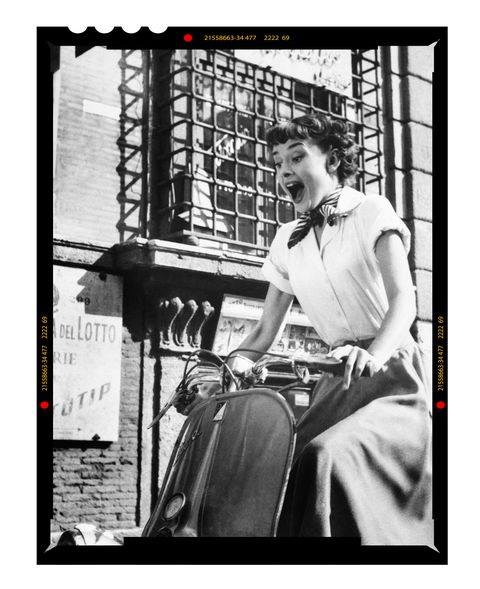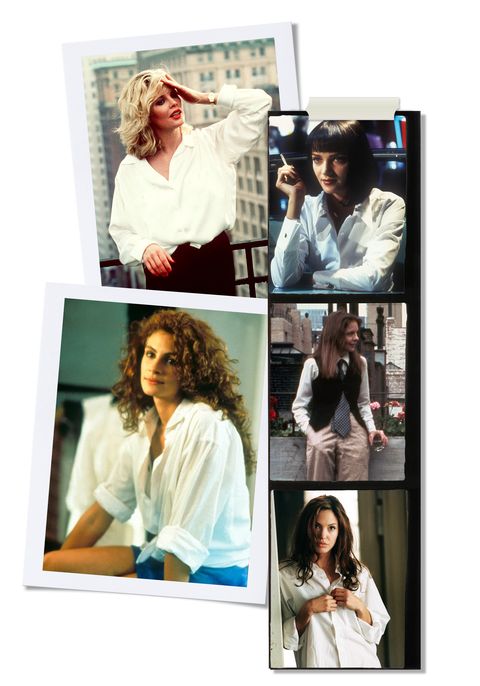The histOne of the most perennially stylish items in a woman’s wardrobe, we look at how the humble white shirt became, and remained, such an important piece of clothingory of the hero: the white shirt
As the fashion industry attempts to manoeuvre itself into a more sustainable place, there has never been more reason to invest in classic capsule pieces – those which you are able to wear season after season, styled in a myriad of ways.
With this in mind, we’re launching a new series, The History of the Hero, which explores the cultural and historical significance of some of the most prevalent trend-less pieces that live in a woman’s wardrobe – and we’ll then guide you on how to make the most of them in yours.
First up is the white shirt, an item that has been at the centre of countless significant moments in fashion, film and cultural history – and one which stems from a much darker past than you might imagine.

The first moment that some iteration of the white shirt found itself in the spotlight in women’s fashion was back in the 18th century, when Marie Antoinette wore a ruffled cotton robe de gaulle in a 1783 portrait, causing something of a scandal at the time.
The portrait, painted by Madame Vigée-Lebrun, depicted the royal in a loose, billowing white blouse dress with minimal jewellery – a far more toned-down and relaxed ensemble than were usually seen in the portraits of her day. The queen’s decision to pose in what was essentially her underwear caused uproar, as did the fact that she was wearing cotton, a relatively inexpensive material compared with the finest silks thought to be more befitting of a royal.
Many historians note the enormous impact this portrait of Marie Antoinette had on the textile industry, encouraging the cotton business and therefore the institution of slavery to grow during and after her lifetime. These ramifications might sound extreme, but the royal’s significant presence on the world stage gave her huge influence; her choice to wear a white cotton blouse a few centuries ago certainly contributed to the white shirt being such a dominant piece in our wardrobes today. But it is also clear now that this seemingly frivolous fashion moment led to catastrophic consequences.
“Marie Antoinette and her fellow fashion trendsetters made cotton desirable,” Caroline London explained in an in-depth account of the historical moment for Racked. “Technology and slave labour made it affordable. It was the perfect storm. The affordability increased the desirability, resulting in an even higher demand, which in turn increased the mass production so that the price dropped even further.”
Marie Antoinette and her fellow fashion trendsetters made cotton desirable
“The cycle caused ‘King Cotton’, and the institution of slavery which it stood upon, to rule the South. Of course, we all know what happened from there. A simple dress launched an elaborate butterfly effect with far-reaching consequences that the young French queen never could have predicted when she took a step outside her lavish royal wardrobe.”ADVERTISEMENT – CONTINUE READING BELOW
Throughout the next century, Marie Antoinette’s impact on the cotton industry was considerable, transforming the manufacturing industry, but the white shirt as we know it now was still only worn by men until the 20th century, where for decades it was associated as a symbol of the wealthy gentleman – one who did not do manual labour (where the shirt would get dirty) and one who could afford to wash his clothes frequently. By the 1920s however, designers including Coco Chanel had broken down gender and class boundaries with a more relaxed and contemporary take on womenswear – in some cases swapping skirts for trousers and corsets for men’s shirts – which helped to bring the white shirt into the realm of women’s fashion.
GETTY IMAGESADVERTISEMENT – CONTINUE READING BELOW
The item then gained serious traction in the 1940s, this time thanks to a number of influential women, including Katharine Hepburn, Ava Gardner, Marlene Dietrich and Lauren Bacall, who put it in the spotlight.

GETTY IMAGES
In fact, it was during the next couple of decades that the white shirt had some of its most prominent movie moments, from Holiday and Key Largo to perhaps one of Audrey Hepburn’s most memorable outfits of all time, a white shirt with rolled up sleeves and a popped collar, which she wore while starring alongside Gregory Peck in Roman Holiday.
During these decades, the white shirt – despite initially being a feature of menswear – on the whole tended to be very much more associated with femininity than it was later down the line. The shirt was often nipped in with a belt at the waist, never buttoned up to the top, and tucked into a skirt, styled with a silk scarf tied around the neck.
It was later then that it developed more of an androgynous reputation – worn by icons such as Patti Smith (who teamed it with a skinny tie); Diane Keaton (with a waistcoat in Annie Hall); Kim Basinger (who wore it oversized in 9 And A Half Weeks); and Uma Thurman wearing it buttoned up with tailored black trousers in Pulp Fiction. It was thrown over a dress in Pretty Woman, tied at the waist in Dirty Dancing and worn with nothing else by Angelina Jolie in Mr and Mrs Smith.

SHUTTERSTOCKADVERTISEMENT – CONTINUE READING BELOW
On the catwalks, the presence of the white shirt was particularly significant in the Nineties and Noughties, where pared-back minimalism ruled in the collections of Calvin Klein and DKNY, later becoming a key piece for Jil Sander and Phoebe Philo’s Celine – and it has continued to dominate well into the next decade.
The white shirt was still a major feature off the catwalk and away from movies, too; stars such as Carolyn Basette Kennedy made the relaxed white shirt part of her uniform, while in more recent times, Meghan, the Duchess of Sussex, ensured it was a key element of her wardrobe, wearing it for her very first appearance with then-boyfriend Prince Harry and consistently turning to it throughout her time as a member of the British royal family. Sharon Stone made it red-carpet appropriate for the 1998 Oscars (pairing her husband’s Gap shirt with her Vera Wang skirt), a route that the likes of Julia Roberts and Emma Watson have since followed. Kate Moss, Naomi Campbell, Marilyn Monroe, Princess Diana, Victoria Beckham, Rihanna, Zendaya, Amal Clooney – it would be difficult to name a stylish woman in the public eye who hasn’t relied on the white shirt for one occasion or another.

GETTY IMAGESADVERTISEMENT – CONTINUE READING BELOW
Its ability to dominate as a must-have item decade after decade is proof that it will probably never go out of style, but exactly what is it that makes it so special and enduring?
“We’ll never get bored of a classic white shirt as it can be styled in so many different ways,” Heather Gramston, head of womenswear buying at Browns tells us. “It works really well with a tuxedo, a pair of blue jeans, a skirt, a pair of shorts – and you can even wear an oversized white shirt on its own for a lazy day at home.”
Part of its appeal and therefore its ability to live on is clearly its versatility, something which Natalie Kingham, fashion and buying director at Matches Fashion, echoes.
The white shirt is a timeless wardrobe staple, it is versatile and has endless styling options meaning it can be worn all year round, season after season
“The white shirt is a timeless wardrobe staple, it is versatile and has endless styling options, meaning it can be worn all year round, season after season. You can throw on a crisp, tailored shirt and instantly look polished and put together, or you can opt for a reconstructed style with more unusual details, but the refined silhouette of the shirt remains the same as it will never go out of style.”
Emma Willis, the designer behind her namesake English shirting brand, agrees: “A well-cut white shirt in a good quality cotton or linen looks so sharp and fresh with everything, whether for business, smart-casual or casual. There is nothing better with jeans, a suit or an evening look.”
But, as well as its seamless ability to go from work to weekend, day to night, the white shit remains so popular because it suits everyone, Willis adds.